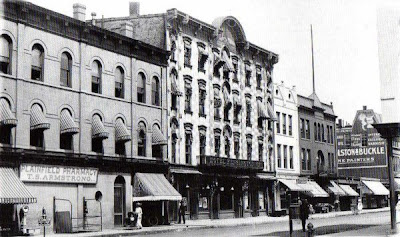Plainfield's history and architecture are laid out in great visual detail in a long-awaited and handsome new book by John Grady and Dorothe Pollard.
You can get your own copy signed by the authors this Saturday at Borders in the Watchung Square Mall. But Plainfield history buffs on your gift list will surely hold it against you if you don't also get an autographed copy for them for the holiday gift-giving season.
Hundreds of photos, drawings and maps, as well as thumbnail sketches of Plainfield personalities and activities and examples of period advertising illustrate the Queen City's history from its first settlement in 1684 to the latest 'remuddling' currently under way.
 |  |
| Clara Louise Tea Room, Exterior | Clara Louise Tea Room, Interior |
Change, they say, is a constant. The elegant Clara Louise Tea Room,
whose gardens backed onto the fabled Tiers (or Boice's) Pond
fell to the fashion of the day when Bamberger's
(now the Supremo supermarket) was built after WWII.
whose gardens backed onto the fabled Tiers (or Boice's) Pond
fell to the fashion of the day when Bamberger's
(now the Supremo supermarket) was built after WWII.
Those interested in Plainfield's priceless treasure trove of magnificent homes dating from the post-Civil War period through the early 20th century will find examples (many previously unseen) of the grand -- and sometimes quirky -- architectural confections that made the city a hit with the prosperous of another age.
To those who formed the earliest commuter generation by migrating to suburbs like Plainfield, the signs of success were substantial homes in well laid out neighborhoods in communities with institutions that radiated solidity and with upscale amenities and shopping opportunities for the formerly sleepy village's new carriage trade.
And those signs were all around us, as the new book handsomely attests.
In eight chapters, John and Dotte cover the ground from the earliest settlers and some of Plainfield's oldest extant homes through the hustle-bustle of the city-building period of the late 19th-century and the desirable railroad suburb which peaked perhaps just before the Great Depression.
One of the most intriguing is an entire chapter devoted to carriage houses and their adaptive reuse. When travel was by horse-drawn buggy or carriage, these outbuildings were eminently practical, providing room for the horses, their tackle and the requisite hay as well as the occasional living space for help.
The advent of the automobile was not kind to many of these outbuildings and their subsequent fate is an interesting chapter. Some became dilipidated and were torn down. Some were separated from their mansions and fashioned into homes in their own right. Some stand unaltered yet today, honoring their past and waiting wistfully for a possible future other than being torn down.
Likewise, the downtown that signified the successful suburb is honored through many photos of the shops and businesses as well as activities that marked a bustling community life. Though most of the businesses (but not all) are long gone, and many of the buildings too, a close reading of the photos reveals that much of Plainfield's heyday downtown architecture survives -- and in surprisingly recoverable form.
Much of East Front Street remains intact, though covered over
at the street level with new shopfronts. Here you see the Drake College
which is now the Armed Services Recruiting Center.
at the street level with new shopfronts. Here you see the Drake College
which is now the Armed Services Recruiting Center.
Sensitive adaptive reuse of these buildings in line with a respectful development in the way of the 'transit-oriented design' which is all the rage these days would benefit Plainfield over the long haul. Although economic conditions of the moment seem to be precluding the intense development that has been promised, the missed opportunities also mean that the downtown streetscape is more than likely to survive basically intact, awaiting a friendlier future.
Will the redevelopment of North Avenue be kind to this magnificent
Victorian commercial block? For now, changes are stalled.
Victorian commercial block? For now, changes are stalled.
But adaptive reuse is a process that can be fraught with difficulty, and the results can sometimes be as disastrous as simply tearing down the old and replacing it with new construction.
duCret Art School student Ralph Attanasia's trenchant take
on the 'cosmetic surgery' old buildings can be subjected to.
Sometimes the verdict about the value of the reuse or replacement is only arrived at after a period of living with the changes.
 |  |
This Victorian residence was replaced... | by this elegant Tudor Revival |
A mansion across the road from the stately Tudor above
was recently demolished to make way for a new house.
Will it be as successful? Only time will tell.
was recently demolished to make way for a new house.
Will it be as successful? Only time will tell.
On the other hand, sometimes the feeling is that no amount of time or ivy (the ultimate cover-up) will make up for the "improvement" done.
This West Seventh Street mansion is the latest to be adapted.
Successfully? You be the judge.
Successfully? You be the judge.
Plainfield, New Jersey's History & Architecture
A Book Signing with Authors
John Grady and Dorothe Pollard
Saturday, September 13
2:00 - 4:00 PM
Borders Books
Watchung Square Mall
Published by Schiffer Books | www.schifferbooks.com/
A Book Signing with Authors
John Grady and Dorothe Pollard
Saturday, September 13
2:00 - 4:00 PM
Borders Books
Watchung Square Mall
Published by Schiffer Books | www.schifferbooks.com/
View today's CLIPS here. Not getting your own CLIPS email daily? Click here to subscribe.













0 comments:
Post a Comment